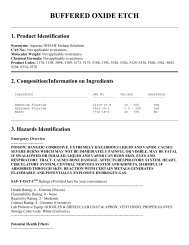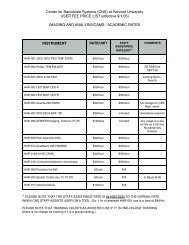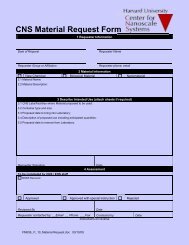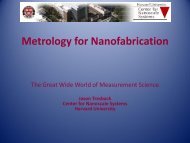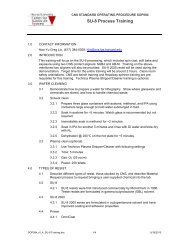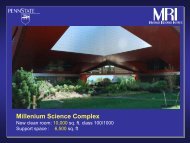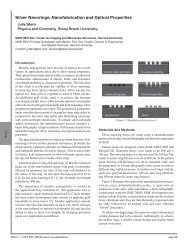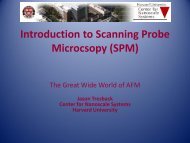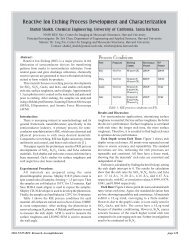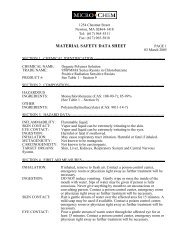SU-8 Photolithography Process
SU-8 Photolithography Process
SU-8 Photolithography Process
You also want an ePaper? Increase the reach of your titles
YUMPU automatically turns print PDFs into web optimized ePapers that Google loves.
CNS Standard Operating Procedure – SOP031<br />
Table1. <strong>Process</strong> Conditions for <strong>SU</strong>-8 photolithography<br />
Required<br />
<strong>SU</strong>8<br />
Thickness<br />
(um)<br />
<strong>SU</strong>-8 type (*1) Sp in Prebakinbaking<br />
Soft-<br />
Exposure (*2) Suggest (*3) Suggest Post-Exp<br />
speed<br />
Energy Exposure Exposure Baking 1<br />
(rpm)/ramp-<br />
time (65C, time (95C, (mJ/cm^2) Energy time (AB- PEB1<br />
time/hold-<br />
time<br />
min) min)<br />
(mJ/cm^2)<br />
(+/-10%)<br />
M) (sec) (65C,min)<br />
Post-Exp<br />
Baking 2<br />
PEB2<br />
(95C,min)<br />
1.5 2 3000/ 8s /60s 1 1 70-100 85 3.5 1 1 1<br />
PGMEA<br />
Develop<br />
time<br />
(min)<br />
Comment<br />
(*4)<br />
Verified<br />
Thickness<br />
(um) -CR1<br />
(*5)<br />
2 2002 3000/ 8s /60s 1 2 70-100 85 3.5 1 1 1 CNS<br />
5 2005 3000/ 8s /60s 1 2 80-120 100 4.2 1 1 1<br />
5 5 3000/ 8s /60s 1 3 80--110 100 4.2 1 1 1<br />
7 2007 3000/ 8s /60s 1 2 90-140 115 4.5 1 1.5 1<br />
10 2010 3000/ 8s /60s 1 2 110-170 140 5.5 1 2.5 2 CNS<br />
10 10 3000/ 8s /60s 2 5 100-170 140 5.5 1 2.5 2<br />
15 2015 3000 / 8s /60s 1 2 120-190 160 6.5 1 2+1 3 CNS 14 (+/-0.5)<br />
20 2015 2000 / 5s /60s 1 3 140-230 190 7.4 1 2+1 3 CNS<br />
25 2025 3000 / 8s /60s 1 3 150--250 200 8 1 3+1 4 CNS 24 (+/-1)<br />
35 2035 3000 / 8s /60s 2 5 180-300 240 9.5 1 3+1 5<br />
40 50 3000 / 8s /60s 5 15 250-300 280 11 1 4+1 6 CNS<br />
50 2050 3000 / 8s /45s 3 6 230-380 310 12 1 7+1 6 CNS 56 (+/- 4)<br />
75 2075 3000 / 8s /45s 3 9 280-470 380 15 1 7+1 7<br />
100 2100 3000 / 8s /45s 5 20 320--540 430 17.5 1 10+1 10 CNS<br />
3000 rpm of spin speed is recommended for the better repeabability of film thickness<br />
Suggest exposure energy is given under follwing conditions: Plastic film pattern mask, a 360nm LP filter to hold the mask and Si substrate<br />
Suggest exposure time is based on the intensity of AB-M at 365nm ~25mW/cm^2<br />
Some of <strong>SU</strong>8 are provided by CNS, as marked in the Comment column,<br />
3 types of <strong>SU</strong>-8 (2015,2025, 2050) have been verified in LISE clean-room of CNS (<strong>SU</strong>-8 banch, rightside spinner, which are highlighted.<br />
6. Exposure<br />
6.1 Two mask aligners in CNS can be used for <strong>SU</strong>-8 exposure: AB-M mask aligner<br />
and <strong>SU</strong>SS MJB4 mask aligner.<br />
6.2 To operate the mask aligner, follow the standard operating procedure for AB-M<br />
aligner (CNS SOP017) or <strong>SU</strong>SS MJB4 (CNS SOP0XX).<br />
6.3 Set the exposure time as recommended in Table 1 and perform the exposure.<br />
Important Note for <strong>SU</strong>-8 UV Exposure:<br />
• For a film (transparency) photomask: place the photomask on top of the<br />
substrate with the printed side of the mask facing the photoresist layer on the<br />
substrate. Mount a blank glass plate on the mask holder.<br />
• Place a 360nm long-pass (LP) filter on the glass plate (or the chrome mask) to<br />
reduce the short wavelength effect and improve the feature profile. Add 20%-<br />
40% more exposure time to compensate for the intensity loss due to the filter.<br />
CNS SOP031 Effective Date: 08/06/08<br />
Version: 2.6 Page 3 of 5 Jiangdong Deng (JD)



